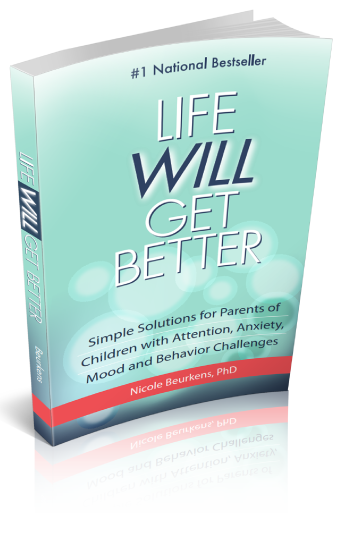We can all agree it’s difficult to get kids to take their supplements unless they are in gummy form and coated in sugar, and this is especially difficult with Omega 3s that can sometimes taste fishy.
In this article, I will share 10 tips on how to get kids to take their Omega 3 fatty acids (fish oil) without having to endure the fishy taste or giant capsule.
If your child has been diagnosed with a neurodevelopmental or mental health issue such as ADHD, autism spectrum disorder, sensory processing disorder, or depression, chances are you’ve heard about the benefits of omega-3 fatty acids. Found in high concentrations in fish oil, these nutrients are important for overall health and can help increase attention, reduce hyperactivity, boost mood, and improve behavior. Typically higher dosing is beneficial to reduce symptoms, and you can learn more about benefits, types, and dosing in this article.
Which foods contain omega-3 fatty acids?
The reason that supplementation is so important in the first place is that omega-3 fatty acids cannot be produced by the body. However, they are also critical for a wide variety of bodily functions. This means we either have to eat enough foods with high levels of omega 3s or take supplements like fish oil. Unfortunately, the list of foods that naturally contain high levels of omega-3 fatty acids is quite short:
- Seafood (particularly fatty cold-water fish like salmon and tuna)
- Nuts and seeds
- Plant oils
Nobody wants to eat fish or seeds all day every day, so we use supplementation as a way to give our bodies enough omega 3s without eating the same things every day!
What time of day is best to take fish oil?
The benefits of omega 3s are based more in the long-term, so in general fish oil can be taken in the day or night time. Some kids might prefer to split the dosing and take half when they wake up and half when they go to bed if they feel it makes it more tolerable. Taking it whenever it’s most convenient is the important part to consider!
The biggest challenge with fish oil is getting kids to take it.
For children and teens who can swallow larger capsules, this isn’t such a big deal. Just keep the capsules in the refrigerator or freezer to reduce any potential fishy taste that might be present. However, children who are not yet able to swallow capsules can be more of a challenge, as liquid fish oil tends to have a distinct strong taste and a very oily texture.
What about gummies …
While fish oil gummies are an option, the typical doses required to improve symptoms is quite high. This means that to get the right dose for your child you will be giving them several gummies per day, every day. The sugar in those gummies really adds up, and it can get expensive. This is why I use and recommend liquid omega-3 as the best option for therapeutic dosing in children who are unable to swallow larger capsules.
Addressing the fishy factor …
Because of the taste and texture issues, liquid fish oil can be one of the more challenging nutritional supplements to get kids to take. Over the years I’ve come up with some ways to make this easier, and have benefitted from the creativity of many of my clinic families as well.
Here are my top 10 tips for getting appropriate doses of fish oil in your kids with minimal complaining:
1. Mix into juice – I’ve found that the best options are citrus juices such as orange or lemonade, but apple, grape, or cranberry work as well.
2. Mix into a smoothie – Smoothies work great because they help mask not only the taste but also the texture of the fish oil. Use whatever smoothie ingredients your child tolerates and blend it up as usual. Then mix in the fish oil. Kids who are very sensitive to texture will probably prefer a thicker smoothie, as it hides the fish oil better.
3. Mix into a spoonful (or an entire serving) of soft food – Options I’ve had success with at my clinic include applesauce, yogurt, pudding, and mashed potatoes. Any soft food will work, but make sure it’s not super hot as high heat can damage the oil and reduce effectiveness.
4. Mix into fruit sorbet – Whether you make your own or buy it at the store, frozen sorbets make a great vehicle for hiding fish oil. Citrus-type flavors tend to work best, but you can try it with any flavor sorbet your child prefers.
5. Make your own smoothie or juice popsicles – All you need is some cheap popsicle molds and either juice or a smoothie mixture for this approach. Pour the juice or smoothie into each compartment, add the appropriate dose of fish into EACH compartment, and stir. Put them in the freezer, and when they are frozen you’ve got popsicles with the proper dose of fish oil for your child to enjoy. Even kids who don’t tolerate the fish oil mixed into juice often do well when frozen into popsicle form like this!
6. Mix into nut butter – Use whatever type of natural nut or seed butter your child prefers and add the fish oil to it before making a sandwich or giving it to your child to dip things in. Because natural nut and seed butter are oily to begin with, the fish oil stirs in easily and the strong nut/seed taste masks the fishy taste.
7. Make a salad dressing – While this isn’t an option I’ve used with lots of kids, it’s been a workable option for a few over the years. If your child likes salad you can make a simple dressing with fish oil to mix with the greens. A basic option is extra virgin olive oil, vinegar, and fish oil, but Caesar dressings and other options can work as well. You can mix with a premade dressing you have on hand, or try various recipes incorporating the fish oil in the process.
8. Make your own gelatin gummies – While boxed Jell-O and gummies at the store tend to be full of ingredients we want to avoid, you can make your own healthy options inexpensively. Wellness Mama has a great simple recipe for homemade gummy vitamins that many families at my clinic have used. When making these with fish oil make sure you allow the mixture to cool a bit after cooking before adding the fish oil. To ensure the proper dose you will need to pour the gelatin mixture into your molds, leaving enough room to mix in the dose of fish oil (or spread a dose out over 2 or more gummies if a larger dose is needed).
9. Try a flavored liquid product – Look for options that disguise both the fishy taste and oily texture. A great option is Designs for Health Omegavail Smoothies that come in citrus, mango, key lime, and lemon drop flavors. The texture is thicker and more smoothie-like in consistency, and the flavors do a great job of masking any fishy taste. With a hefty dose of EPA and DHA in every 1-tablespoon serving these are tolerated by many kids on their own, or can easily be mixed into other food items. When looking at flavored fish oils make sure to avoid products with artificial sweeteners, dyes, or chemical flavorings.
Click here to find these Omegavail Smoothies on the Designs for Health Amazon store and use code DFH63194 to save 10%.
10. Drink it straight – While I don’t find that most kids prefer this, I’ve known several over the years (including one of my own children) who actually just take their fish oil straight off the spoon or in a tiny cup. They can follow it up with a preferred beverage or food item to avoid any aftertaste. This is certainly the easiest way to get it done, and you might be surprised to find that your child is willing to do it!
This is important …
Note that when mixing fish oil into food or beverages you want to ensure you are giving your child an amount they will actually eat or drink. For example, scoop out an amount of sorbet or applesauce your child will eat in one sitting and then mix the fish oil into it. This ensures that they get the proper dose each time.
At what age should you start taking omega-3 fatty acids?
One of the reasons that strategies like these are so important is because even infants can benefit greatly from omega-3 supplementation. Often, kids might grow out of their dislike for the texture or taste of fish oil, but especially many young kids will need some more convincing. Using these tips to start your kids on fish oil early can provide them tons of benefits in the future!
All I can say is …
These strategies have worked well for many families in my practice. I’d love to hear more about your challenges and successes. Have you found creative ways to help the “medicine go down” so to speak? Share in the comments below.
What You Should Do Next:
Sign up for my Better Behavior Naturally community newsletter
Sign up for my newsletter to get tips, resources, and supports to improve your child’s attention, anxiety, mood, and behavior…while making your job as a parent easier.
Enroll in one of my workshops
Check out one of my many workshops where you’ll join my exclusive community of parents in a one-of-a-kind virtual resource accessible 24/7. Whether you’ve got a child with a diagnosis like autism or ADHD, or are becoming more and more frustrated with a child who struggles to listen and cope, these workshops are designed to give you the information, tools, and support you need…whenever you need it.








